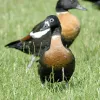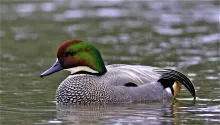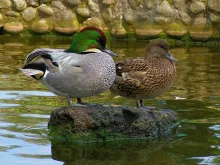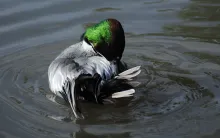
Falcated duck (Mareca falcata)
Species name
- Dutch name:
- Sikkeleend
- English name:
- Falcated Duck
- German name:
- Sichelente
- French name:
- Canard à faucilles
- Scientific name:
- Mareca falcata
Scientific classification
- Order:
- Anseriformes
- Family:
- Anatidae
- Onderfamilie:
- Anatinae
- Genus:
- Mareca
Description
- Description:
Male:
Has purple-chestnut head with green and bronze iridescence, white throat and fore neck crossed by green collar, grey body with profuse black crescents on breast, grey and black sickle-shaped secondaries covering black and yellow-buff stern, and pale grey forewing. buff and black undertail coverts, and elongated, arched tertails. Eclipse male is like the female, but darker on the back and head.Female:
Grey forewing, and green-and-black speculum. Females are dark brown. Its long grey bill is an aid to identification.
In flight both sexes show a pale grey underwing. The blackish speculum is bordered with a white bar on its inner edge.Juveniles:
Are buffer than the female and have short tertails.
Standard Measurements
- Body Length (cm):
- The male (drake) of the Falcated duck measures approximately 46-53 centimeters. The female measures approximately 46-53 centimeters.
- Body Weight (grams):
- The male will weight about 420-760 gram. The female will weight about 420-760 gram.
The weight is notoriously variable and can only be used as indication!
- Note:
Nest is built in ground, near water, under cover of tall, dense vegetation. Nest typically made of grasses and forbs and lined with down.
- Breeding:
- The female Falcated duck usually lays from 6-10 cream-white eggs and incubates them for 25-26 days.
- Artificial incubating:
The ideal relative humidity for incubating most waterfowl eggs is 55% (ground nesters) and 40% (cavity nesters). The temperature is usually 37.4°C. Set ventilation as recommended by the incubator manufacturer. Eggs must be turned, either automatically or by hand, a minimum of 4 times a day. As the duckling develops there is a loss of water from the egg and the air sac gets bigger. In normal development of an egg with a 25-26 days incubation, the air sac occupies about a third of it three days earlier. Cleanliness is vital and ideally eggs should be moved to a separate hatcher at this point, where the humidity should be increased to 65% and even higher once they have pipped internally.
- Bird banding:
- Recommended closed leg band ring size for the Falcated duck is 10 mm.The leg band ring can only be applied on a young dabbling duck at around 12 days old.
- It doesn't matter what leg that you band, but it's good to have a consistent system. Suggested: Left leg = Female, Right leg = Male
- Maintenance food:
-





Floating full food for all sea ducks, green ducks, eider ducks and geese, especially in the moulting and breeding phase ideally suited. Packed with wholesome raw materials, natural vitamins and trace elements, this performance food with a protein content of 30% forms the basis for lifelong vitality.
- Regulation:
Het is niet verboden om deze vogels te houden die van nature in Nederland voorkomen, op voorwaarde dat deze vogels in gevangenschap zijn geboren; nakweek dus. Deze vogels zijn voorzien van een gesloten pootring. Het is wel verboden om deze vogels te houden die in het wild gevangen zijn. Alleen bepaalde instanties, zoals vogelasiels en vogelhospitalen, zijn bevoegd om jonge en gewonde wilde vogels te houden. Deze bescherming van vogels wordt vormgegeven door schadelijke handelingen te verbieden zoals:het doden, verwonden, vangen, bemachtigen en met het oog daarop opsporen van vogels (art. 9 Flora- en faunawet); het opzettelijk verontrusten van vogels (art. 10 Flora- en faunawet);het beschadigen, vernielen, uithalen, wegnemen en verstoren van nesten, holen of andere voortplantings- of vaste rust- of verblijfplaatsen van vogels (art. 11 Flora- en faunawet);en het zoeken, rapen, uit het nest nemen, beschadigen of vernielen van eieren van vogels (art. 12 Flora- en faunawet).



